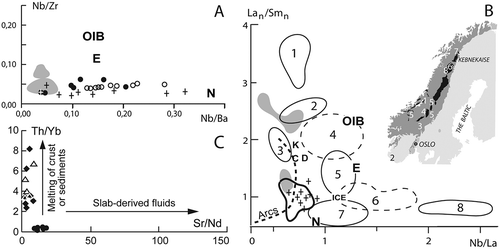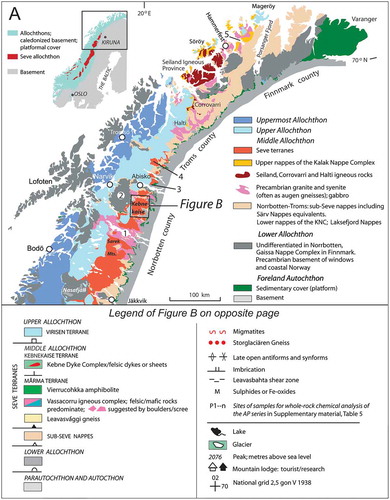Figures & data
Figure 2. A. Plane polarized light view of andalusite (chiastolite) porphyroblast which is replaced by radial bundles of prismatic sillimanite, and rimmed by idioblastic garnets (G). Leavasvággi gneiss, (N68.061303°/E18.943689°). B. Close-up of Figure A (frame) under crossed nicols. C. Leavasvággi gneiss with typical red-brown colour, and an extremely thin band of metabasite. East of Moarhmma glacier (N68.081593°/E18.734316°). D. Leucosomes wrapping disrupted metadolerite boudin. Eastern slope of Godučohkka (N68.148153°/E18.666002°).
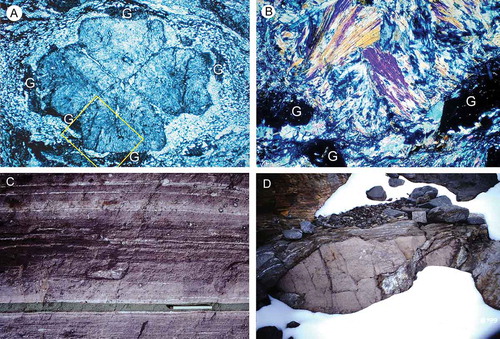
Figure 3. A. Stromatic migmatite at Mårma glacier (68.078303°/18.729586°). Right half of Figure A shows the L>S tectonite character of the migmatite: upper left specimen with fresh parting along the pervasive foliation. Upper right: section cut normal to foliation. Bottom: section cut normal to lineation. B. Beneath knife: distinct, fine-grained granitic dyke, rich in small garnets. C. The fine-grained domain is composed of quartz, feldspar and biotite and overgrown by abundant small garnets. Rims of leucosomes contain peritectic garnets (at arrows). Palaeosomes include garnet and sillimanite in addition to biotite. Leavasvággi gneiss, northern slope of Alesätno valley (N68.199906°/E18.790317°). Spec. A90–20. D. Plane polarized light view of garnet porphyroclasts (within white lines) which preserves prism (2-mm long) and raft of sillimanite (S; within black lines), and dark brown biotite flakes with preferred orientation (arrows). Muscovite (Ms) occurs as large and numerous small fish. 1: Feldspar porphyroclasts. 2: Bands of mosaic quartz. Dark bands consist of very fine-grained biotite. SG at the type locality (N67.907414°/E18.591703°). Long side of photo is 3.5 mm. Spec. A87–256.
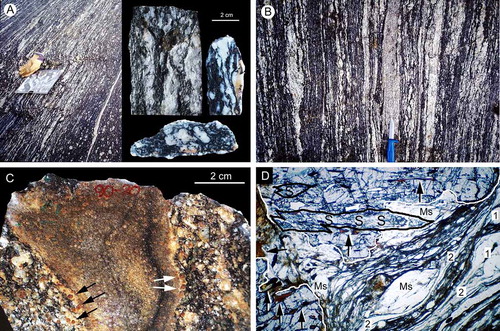
Figure 4. Vássačorru igneous complex. A. Typical net-veined outcrop, cut by late dyke. At Mårma glacier (c. N68.076431°/E18.711872°). B. Mingled mafic rocks and Vistas Granite (N68.078309°/ E18.541993°). The two boulders with mafic enclaves shown in Figure C occur downstream this outcrop. C. The inset figure in the upper right corner is a close-up of folded pillows in the boulder in the background. D. Mafic magmatic fragments in an inhomogeneous hybrid rock formed by mixing of dolerite and granite (N68.068772°/ E18.935717°; same locality for Figures E–F). Varying darkness of fragments reflects different stages of hybridization. The fragment below the hammer is partly angular suggesting some consolidation; note dark, rounded enclave inside the fragment. Above hammer, a xenolith of metasedimentary rock. Inset figures show fragments charged with (upper corner) or rimmed by (lower corner) porphyroblasts of garnet. E. Xenolith of psammitic rock in hybridic granitic rock. F. Xenolith of calc-cilicate rock cut by granitic veins with pegmatitic core. Mafic fragments are rimmed by, or invaded by (right), garnets. Sparse xenocrysts of feldspar.
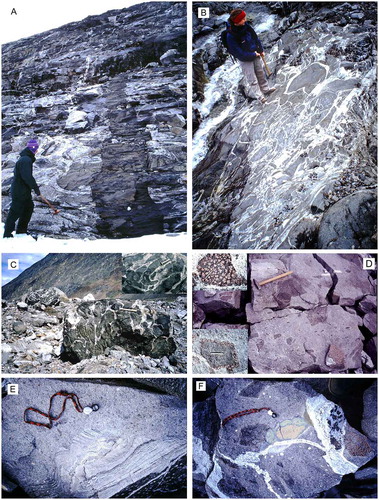
Figure 5. A. Mafic rocks of the Mårma terrane according to the geochemical classification method of De la Roche et al. (Citation1980). Crosses: dolerites of the VIC (n = 9). Circles: Vierručohkka amphibolite (n = 12). Legend: 1 = picritic basalt/ ultramafic rocks. 2 = alkali basalt/alkali gabbro. 3 = olivine basalt/olivine gabbro. 4 = tholeiitic basalt/noritic gabbro. 5 = trachybasalt/syenogabbro. 6 = latitic basalt/monzogabbro. 7 = andesitic basalt/ gabbrodiorite. B. Diagram designed by Pearce (Citation1983) to estimate the extent of crustal contamination of a basaltic magma. Pure mantle enrichment concentrates Th and Ta with the same rate and their ideal variation therefore defines a band (grey field) with the slope of unity. Th is more sensitive than Ta to upper crustal contamination, Yb is not sensitive. Therefore, basalts contaminated by subduction zone fluids or continental crust tend to plot along trends indicated by arrows 1 and 2, respectively. Arrows 3 and 4 represent within-plate enrichment and fractional crystallization, respectively. Dots: Mafic rocks of the Kebne Dyke Complex, central massif. N, E and OIB are reference compositions for N-MORB, E-MORB and oceanic island basalts, respectively (Sun & McDonough Citation1989). CAB: calc-alkaline basalts; THO: tholeiitic basalts.
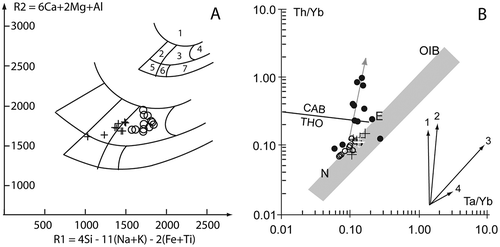
Figure 6. Mafic rocks of the Mårma and Kebnekaise terranes; symbols as in Figure 5. A-B: Discrimination diagrams according to Meschede (Citation1986) and Wood (Citation1980). 1: within-plate (WP) alkali basalts; 2: WP alkali and tholeiitic basalts; 3: E-MORB; 4: WP tholeiites and volcanic arc basalts; 5: N-MORB and volcanic arc basalts; 6: tholeiites of volcanic arcs; 7: calc-alkaline arc basalts; 8: tholeiitic WP basalts. Grey field in Fig. A: Lower Seve Nappe of the central Scandes (Z. Solyom, P.-G. Andréasson and I. Johansson, unpublished results). C. Primitive mantle-normalized multielement diagram for the VIC dolerites. D. REE contents of VIC dolerites. E–F. Ditto for the Vierručohkka amphibolite. Normalizing factors for primitive mantle and chondrite from Palme & O’Neill (Citation2004); for E-MORB from Sun & McDonough (Citation1989).
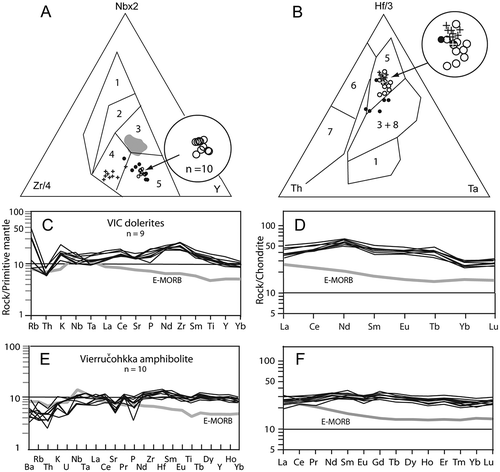
Figure 7. Vistas Granite. A. Typical coarse-grained, slightly deformed variety (N68.077075°/E18.542358°). B. A widespread protomylonitic variety of the Vistas Granite (N68.077592°/E18.561136°). Most of the porphyroclasts are Carlsbad twins, some mantled, with their twin planes subparallel to the mylonitic foliation.

Figure 8. A. Granitoid rocks of the Mårma and Kebnekaise terranes according to the geochemical classification method of Debon & Le Fort (Citation1983). Diamonds: Vistas Granite. Filled diamonds: granitoid dykes and sheets of the KDC. G: Gaskkasjávri granite. B–C. Classification diagrams of Whalen et al. (Citation1987). Boundary lines divide granites derived from recycled continental crust (A-type) from those derived from sedimentary (S-type), igneous (I-type) or subducted oceanic crust, or mantle (M-type); cf. Chappell & White (Citation1992) and Collins et al. (Citation1982). Small grey field (L) is the Litlefjord Granite (cf. Discussion). D. Primordial mantle-normalized incompatible element diagram for the Vistas Granite. Grey line in D and E: reference composition of the upper continental crust (Rudnick & Gao Citation2003). E. REE variation diagram for the Vistas Granite. F. Primordial mantle-normalized incompatible-element contents of granitoid dykes and sheets of the KDC. In diagrams F and G: Grey field: granodiorite and quartz-monzonite. Thin black line: granite. Fat black line: reference composition of upper continental crust (Rudnick & Gao 2003). G. REE variation diagram for granitoid dykes and sheets of the KDC. Normalizing factors for primary mantle and chondrite in all diagrams: Palme & O’Neill (Citation2004).
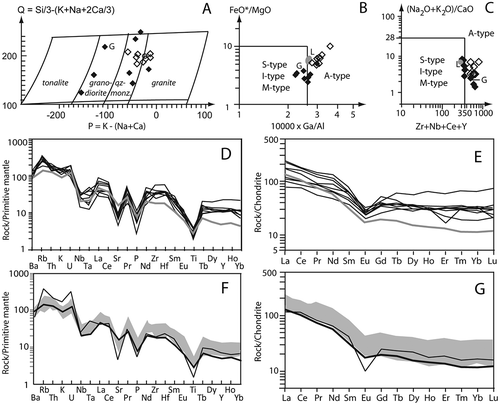
Figure 9. Kebne Dyke Complex. A. Dolerite dyke chilled against a medium-grained, plagioclase-porphyritic dyke. Diameter of coin: 28 mm. (N67.926902°/E18.558531°). B-C. Normal appearance of the KDC. The deformed and amphibolitized complex preserves evidence of different dyke generations. Note isoclinally folded band of felsic rock along right margin of figure C. Vaktposten (B) and Knivkammen (1878), western wall (C). D. Parallel and crossed polarized light views of ‘necklace’ rims of idioblastic garnets growing along the interface of clinopyroxene (p) and plagioclase (white). r: rutile. a: amphibole. Quartz is seen (crossed nicols) as small, white spots. Height of figure is 1.5 mm. Spec. A87–258 g. (N67.909292°/E18.576192°). E. Foliated felsic dyke of the KDC. (N68.007581°/E18.315936°).
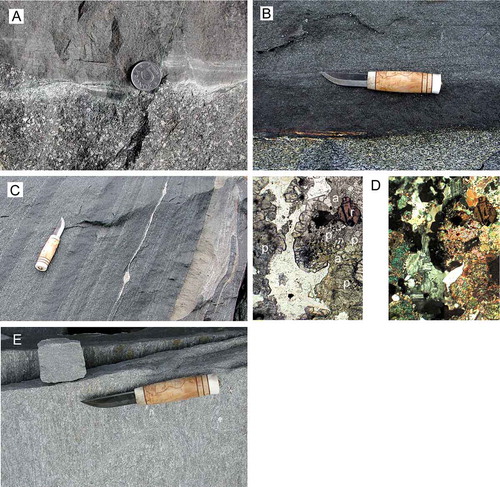
Figure 10. A. Mafic rocks of the KDC according to the geochemical classification method of De la Roche et al. (Citation1980). Black dots: samples from the central massif (n = 7). Grey dots: samples from the Tarfala area (n = 17). Legend: 1 = picritic basalt/ ultramafic rocks. 2 = alkali basalt/alkali gabbro. 3 = olivine basalt/olivine gabbro. 4 = tholeiitic basalt/noritic gabbro. 5–7: cf. Fig. A. B. Incompatible element contents of mafic rocks from the KDC (central massif) normalized to primordial mantle. Grey line: E-MORB. C. Chondrite-normalized REE contents of mafic rocks from the KDC (central massif). Grey line: E-MORB. D. Chondrite-normalized REE contents of mafic rocks from the KDC in the Tarfala area; (n = 10). Heavy black line: E-MORB. Normalizing factors for primordial mantle and chondrite from Palme & O’Neill (Citation2004); for E-MORB reference lines from Sun & McDonough (Citation1989).
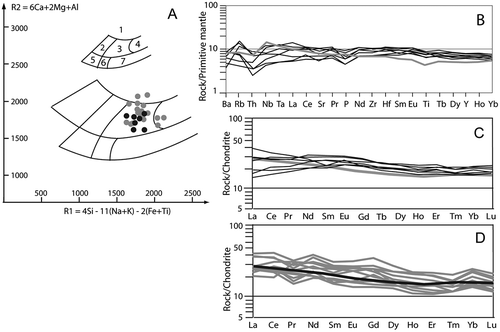
Figure 11. Stereographic plots of foliations and trends of fold axes and lineations of Seve and sub-Seve terranes in the Kebnekaise Mts. For linear structures, planes dipping > 5° were unfolded. White dots in left bottom diagram refer to the base of the entire nappe pile. Equal-area projections: “cont.” = contour percentage intervals. A denotes structures formed mainly during amalgamation of the Mårma and Kebnekaise terranes; S mainly during Scandian accretion of the composite terrane and P mainly during postaccretion warping and faulting. 1: calculated from limbs of large-scale steep folds in central part of the KDC (cf. Fig. B). 2: Transport-parallel fold at the base of the KDC (cf. Fig. C). 3: Refolded transport-parallel folds in shear zone within the Mårma roof zone. 4: Transport-parallel fold shown in Fig. D. 5: Open fold in the Mårma terrane, λ c. 50 m; axis orientation calculated from 25 planes (c. N68.014567°/E18.431133°). 6: Lineation of stromatic migmatite in Fig. B. 7: Stretching lineation and rodding of leucosome in neck of metabasite boudin (c. N68.148153/E18.666002). Stereonet: Allmendinger et al. (Citation2013); Cardozo & Allmendinger (Citation2013).

Figure 12. A. Typical fissile foliation of amphibolite of the KDC when outcropping close below the Köli/Seve thrust. Dip: 22° W. (N67.926105°/E18.324144°). B. Hinge zone with M-fold in a kilometre-scale system of steep, NNE-trending folds in KDC of the central massif (N67.935994°/E18.486218°). C. WNW-trending, recumbent transport-parallel fold at the base of the KDC (N67.956909°/E18.498331°). D. Psammitic gneiss of the Mårma terrane folded by steeply raised, isoclinal, transport-parallel (125°) folds (N67.90733°/ 18.80035°). E. 400 m to the east of the locality shown in D, the gneiss is overlain by the Vierrutjohkka amphibolite, with isoclinal, transport-parallel (100°) folds. F-G. Non-cylindrical fold above a stack of sheath folds. Leavasvággi gneiss (N68.093349°/ E18.985121°); view towards NNE. G. Close-up of lower part of Fig. F. (P is the same point as in Figure F). The white line traces the nose of a sheath fold. Note lineation (at hammer) on the vertical face of the non-cylindrical fold.
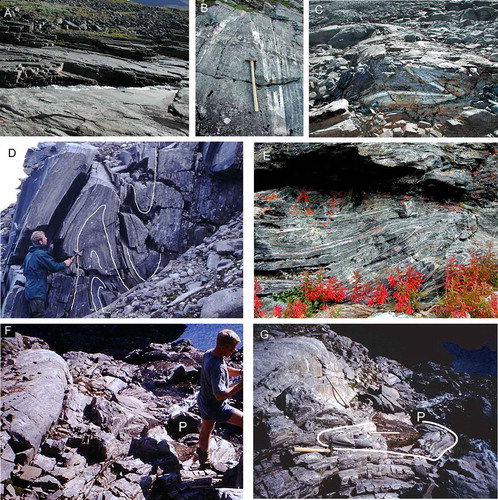
Figure 13. A. Left figure: spaced shear zones (black strokes at horizon) in mylonitic granite at the base of the Mårma terrane (N68.077610/E18.546437). View towards south, i.e., ramp towards west. Right figure (red frame in left figure seen from above) shows the typical transverse (compass shows 90°) lineation defined by stretched quartz and K-feldspar. B. Normal faults running N–S and displaying ductile shear. View towards south. Leavasvággi gneiss, Mårma terrane (N68.117884°/E18.806408°). C. Inferred imbrication of the basal part of the VIC. South-western slope of Vássačorru, view towards north-east. D. Close-up the c. 500-m-high wall within framed section of Fig. C.
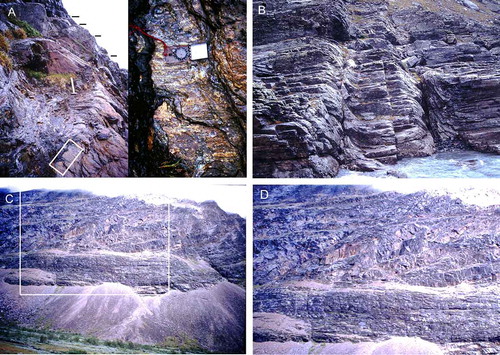
Figure 14. The boundary between the Mårma and Kebnekaise terranes exposed in front of the Reida glacier at Vaktposten. Brown mylonitic Leavasvággi gneiss is overridden by amphibolites of the KDC. B–E. Progressive deformation of the gneiss towards the thrust shown in Fig. A.: stromatic migmatite of the Mårma terrane (B) passing into crenulated migmatite with subhorizontal axial planes (C) and Storglaciären gneiss (D) and, eventually, into mylonite (E). Knife in Figure C is 18-cm long.

Table 1. U–Pb analytical data of titanite from the Gaskkasjávri granite. (Sample 94001, Laboratory for Isoptope Geology, Swedish Museum of Natural History, Stockholm. Analyst: Hans Schöberg).
Figure 15. A. Fabric of the Gaskkasjávri granite. Arrow: garnet porphyroblast. Long side of picture is 35 mm. B. Photomicrograph of the biotite fabric in A. Titanite (arrows) occurs as small idioblastic crystals often aligned with the biotite fabric, or as larger fragments. C. Concentrate of titanite with smaller lenticular grains and larger fragments, the latter often pitted by resorption and carrying opaque inclusions (sulphides). 255X. D. U–Pb concordia diagram for titanite analysis.
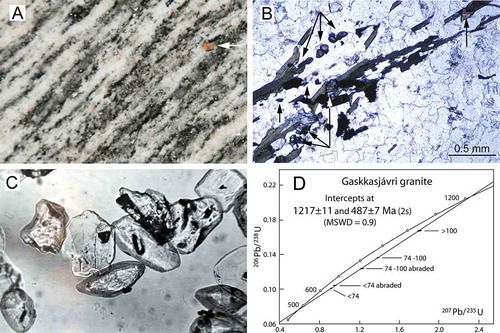
Figure 16. A. The VIC, VA and KDC plot along a line between the estimated composition of < 1.1-Ga subcontinental lithospheric mantle (grey fields) and a depleted magma source. Upper grey field represents the Blekinge-Dalarna Dolerites (n = 20; Solyom et al. Citation1992), lower grey field the Dal Group basalts (n = 10; Brewer et al. Citation2002). Symbols as in previous figures. E, N = E-MORB and N-MORB reference compositions (Palme & O′Neill Citation2004); OIB from Sun & McDonough (Citation1989). Discrimination method from Hooper & Hawkesworth (Citation1993). B. Variation of various groups of Baltoscandian rift and COT magmatism with regard to LREE enrichment and Nb depletion/enrichment, and comparison of these groups with reference compositions of N-MORB (N), E-MORB (E), ocean–island basalts (OIB and flood basalts (K = Karoo; C = Columbia River; D = Deccan). ICE = Iceland. Method and most reference compositions adopted from Hollocher et al. (Citation2007). Upper grey field: Volyn flood basalt, n = 16 (Shumlyanskyy & Andréasson Citation2004). Lower grey field: Siberian traps, n = 20 (Hawkesworth et al. Citation1995). Samples of both fields were filtered to the composition: 46–49 wt.% SiO2; 1.3–2.9 wt.% TiO2; 0.3–1.0 wt.% K2O. Field with thick line: KDC filtered for contamination, n = 16 (this study; Baird et al. Citation2014; Kirsch & Svenningsen Citation2016). Field 1 : Alkaline Särv dolerite, Leksdal Nappe, n = 5 (Solyom et al. Citation1985, ; Nb = 0. 76*Nb1985). 2 : Egersund dyke swarm; aphyric dykes, n = 6 (Bingen & Demaiffe (Citation1999). 3 : Hedmark Group basalts adjacent beneath the Moelv tillite, corresponding to the c. <596 Ma Late Neoproterozoic glaciations; n = 10 (Furnes et al. Citation1983; Kumpulainen et al. Citation2016; Bingen et al. Citation2005). 4 : Amphibolites of the Sylarna Mts., n = 20 (Pettersson Citation2003); 5 : Särv and Saetra type dyke swarms cutting sediments and basement plinths of rift basins (Solyom et al. Citation1985; n = 5; Hollocher et al. Citation2007; n = 91). 6 : Sarek Dyke Swarm, n = 20. (Andréasson et al. Citation1992; Svenningsen Citation1994b). 7 : Troms county dyke swarm, n = 20 (Stølen Citation1997). 8 . Coronitic dolerites and eclogites of the Grapesvare Nappe, Seve terranes, n = 10 (Andréasson & Albrecht Citation1995). Crosses: dolerites of the VIC. C. The KDC (dots) magma was influenced neither by subduction processes, as indicated by low contents of elements with preferential transport in fluids (Sr), nor by elements inherited from melted sediments (Woodhead et al. Citation1998). The trend shown by the Vistas Granite (diamonds) could indicate melting of crustal wall-rock. Triangles: Litlefjord and Revsneshamn granites (Kirkland et al., Citation2006).
